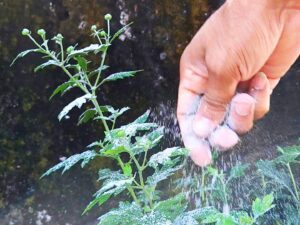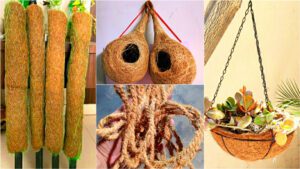Coconut husk
The coconut husk is a fibrous layer that surrounds the coconut fruit and serves as a protective shield for the inner fruit.
Coconut husk not only protects the inner fruit but also provides several valuable by-products that have various applications in different industries.
Coconut husks can be transformed into eco-friendly and sustainable products after going through a series of innovative processes, and these products can be used in gardening, industries, and day-to-day life.
By-products of coconut husk
A “by-product” refers to a secondary product that is created in addition to the main or intended product. Although by-products are not the primary focus of the process, they still have value and can be used for a variety of purposes.
By-products/leftover stuff can be reused, recycled, or repurposed to reduce waste and make things better.
Coco Peat (Coco Coir)
Cocopeat, also known as coir pith or coco dust, is one of the best by-products of coconut husk, and it is obtained by processing and grinding the fibrous material of the husk.

Its excellent moisture retention and antifungal properties make it the ideal choice for gardening, and anyone can easily make this ultimate growing medium at home for their roof garden.
Cocopeat is mainly used in
-
- Horticulture and gardening
- Seed starting and germination
- In hydroponics
- Potting mix
Coconut Fiber (Coir Fiber)
These are the long fibers extracted from coconut husk before it is converted into cocopeat. Coir fibers are extremely strong and durable.
These fibers have a natural ability to resist water and decay, which makes them a great choice for outdoor applications.
These fibers are widely used for making-
Coir Ropes and Twine:
Coir fibers are strong and durable, making them suitable for the production of ropes and twine. These products are extremely useful in agriculture, construction, and various crafts work.
Coir Mats and Rugs:
Coir fiber can be woven or tufted to make mats and rugs. These are popular because of their durability and ability to withstand heavy foot traffic. They are commonly used as doormats, floor coverings, and in entryways.
Biodegradable Coir Pots and Planters:
Coir fiber is used for making biodegradable pots, planters, and coco fiber poles for supporting climbing plants and vines.
Crafts Items:
Coir fibers are often used in crafts and DIY projects to create items like baskets, coir bird nests, and decorative ornaments.
Filling Material For Mattress:
Coir fibers can be processed and used as filling material for mattresses, and cushions due to their resilience and breathability.
Coconut husk Chips (Coco Chips)
The small pieces or chunks of coconut husk are known as coco chips or coconut husk chips.
Coconut husk chips are well-known for their high water retention abilities and resistance to breaking down easily. Because of these qualities, they have become a popular medium in gardening and horticulture.
Coco chips are commonly used in:
Mulching: Coco chips are an excellent choice for mulching the plants. We can use coco chips to cover the soil to retain moisture and avoid weed growth.
Hydroponics: People who grow plants without soil, often use coco chips. these chips provide support for the plants and help maintain moisture levels in plants.
Composting: Coco chips can be added as a composting material to improve aeration and help break down organic matter.
Orchid Cultivation: Orchids like growing in coco chips. The chips provide good aeration and drainage, which orchids really enjoy.
Coconut Shell Charcoal:
The hard coconut shell is an integral part of the husk and the main protective shield of the inner fruit. This hard shell can be converted into charcoal by heating in a controlled environment without oxygen. This process is called “carbonization”.

This coco shell charcoal can be used in
(i) Water Filtration: Charcoal made from coco shells has excellent absorption capabilities. This charcoal removes impurities and pollutants from water, making water fresh and tasty.
(ii) Alternative to conventional charcoal.
(iii) A soil amendment: In gardening, it’s used as a soil amendment to improve soil quality. It also helps the soil to hold water and nutrients, making plants grow better.
(iv) Beauty products: Coco shell charcoal is used in various beauty products such as soap and face packs, to clean and refresh your skin.
(v) Fuel: People in many places use it as a clean-burning fuel for cooking, as it burns without producing a lot of smoke or harmful fumes.
Coconut Husk Ash
Coconut husk ash is produced by burning coconut husks. It is an eco-friendly option for waste management that aids in the recycling of coconut husk waste.
This ash has applications such as
In some places, people use it to make soap because it’s a good cleaning agent.
Soap making: Nowadays coco husk ash can be used to make soap. Because of its good cleaning properties, many traditional soap-making companies are using it as a key ingredient.
Pest Control: Sprinkling coco husk ash around the plants can keep many pests away, like slugs and snails.

Soil Conditioner: It can improve the texture of garden soil. It makes heavy soils lighter and helps sandy soils hold more water
To adjust soil pH: Some soil can be too acidic or too alkaline, which is not good for plants. Coco husk ash can be used to balance the pH level of the soil, making it just right for plants to thrive well.
These by-products of coconut husk reveal the versatility of this natural resource. The Proper utilization of these by-products promotes responsible resource management and eco-friendly practices.



Simply desire to say your article is as surprising The clearness in your post is simply excellent and i could assume you are an expert on this subject Fine with your permission let me to grab your feed to keep up to date with forthcoming post Thanks a million and please carry on the gratifying work
thanks for appreciation..